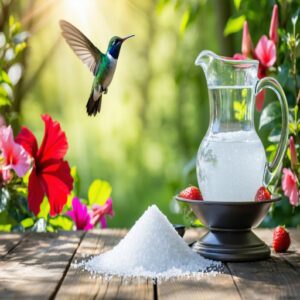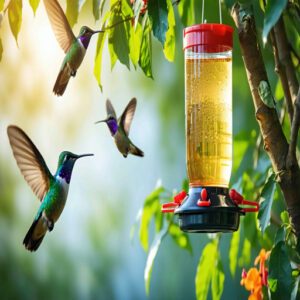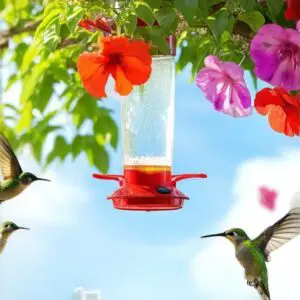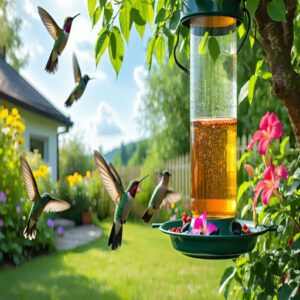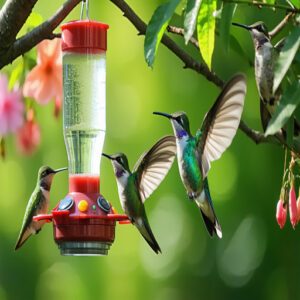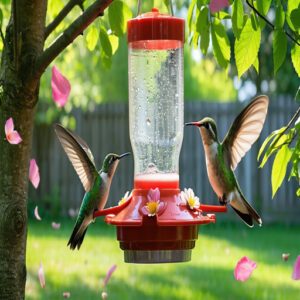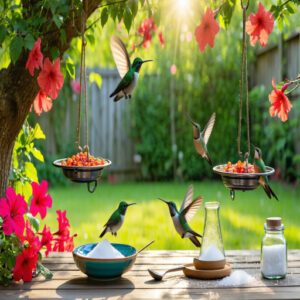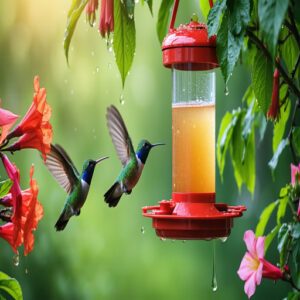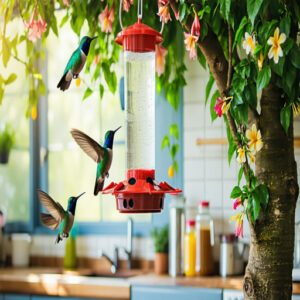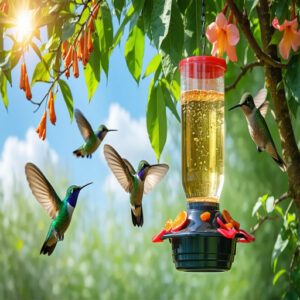This site is supported by our readers. We may earn a commission, at no cost to you, if you purchase through links.
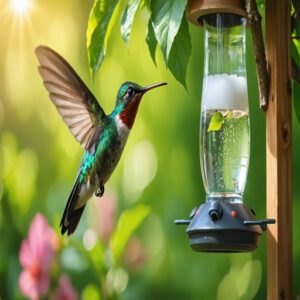
Use hot tap water for a no-boil approach, stirring until the sugar dissolves like magic.
For extra safety, boiling your mixture guarantees it’s pure and contaminant-free.
Skip brown sugar, honey, or artificial sweeteners—they’re like candy bars for these little guys, and not the good kind!
Once it’s ready, let it cool and pour it into a clean feeder.
Store leftovers in the fridge for up to two weeks.
Curious about feeder tips or nectar shelf life? Stick around!
Table Of Contents
- Key Takeaways
- Choosing The Right Ingredients
- Creating Hummingbird Sugar Water
- Hummingbird Sugar Water Recipe
- Hummingbird Feeder Selection
- Hummingbird Feeder Placement and Maintenance
- Hummingbird Attraction and Habitat
- Hummingbird Diet and Alternative Foods
- Common Hummingbird Feeding Issues
- Hummingbird Nectar Shelf Life and Storage
- Hummingbird Feeding Tips and Reminders
- Frequently Asked Questions (FAQs)
- What is the correct ratio of sugar to water for hummingbirds?
- Why do you have to boil sugar water for hummingbirds?
- What does 4 parts water and 1 part sugar mean?
- How long to leave sugar water in a hummingbird feeder?
- How long can sugar water sit out for hummingbirds?
- Is 3 1 or 4 1 better for hummingbird food?
- How often should I clean my feeder?
- Should I add food coloring to the nectar?
- What sugar types are safe for hummingbirds?
- How can I prevent mold growth in nectar?
- Conclusion
Key Takeaways
- Use 1 part white granulated sugar to 4 parts clean water for the perfect nectar ratio; avoid honey, brown sugar, or artificial sweeteners.
- Clean and refill feeders every 2-3 days, or more often in hot weather, to prevent mold and spoilage.
- Skip food coloring—it’s unnecessary and potentially harmful; hummingbirds are drawn to the feeder’s color, not the nectar.
- Store unused sugar water in the fridge for up to two weeks to keep it fresh and safe.
Choosing The Right Ingredients
Making hummingbird sugar water starts with choosing the right sugar water ingredients.
White granulated sugar is your go-to—don’t sneak in brown sugar, powdered sugar, honey, or artificial sweeteners.
These can harm the tiny fliers.
For water quality, stick to clean tap water or filtered water, but skip distilled water since it lacks natural trace minerals.
While organic options sound tempting, all-natural additives aren’t necessary and may upset the balance of the sugar water ratio.
The ideal sugar water mixture mimics flower nectar: one part sugar to four parts water.
Keep it simple—hummingbirds don’t need fancy, just safe and sweet.
Imagine making lemonade for these feathered VIPs: nothing extra, nothing harmful, just the perfect sugar water recipe to keep them coming back.
Creating a bird friendly environment is also essential for attracting a variety of birds to your yard.
Creating Hummingbird Sugar Water
Making sugar water for hummingbirds is simple and only requires the right ratio of sugar to water.
With a little effort, you can create a safe, nutritious nectar that mimics what they’d find in nature.
No-Boil Sugar Water Method
Who says you have to boil water? The no-boil sugar water method is a breeze!
Just mix 1 part sugar with 4 parts hot tap water and stir until the sugar dissolves completely.
It’s quick, safe, and perfect for busy hummingbird fans. Keep unused nectar in the fridge for up to two weeks.
Follow this simple sugar water recipe to keep your feeders stocked and your hummingbirds healthy.
Boiling Sugar Water for Hummingbirds
Boiling sugar water for hummingbirds is like giving their favorite treat a clean slate.
It’s simple and packs plenty of benefits.
- Water Purification Methods: Heating zaps away impurities, keeping their nectar safer.
- Sugar Dissolution: Boiling helps sugar blend smoothly, so no clumpy bits clog your feeder.
- Nectar Purity: Hummingbirds can sip happily, with no funny tastes or rogue contaminants.
Understanding their hummingbird feeding habits is essential for creating an effective sugar water recipe.
Let the mixture cool completely before filling your feeder—hot nectar’s a no-go.
This sugar water recipe might just make your feeder the neighborhood hangout!
Who knew boiling techniques could be this rewarding?
Correct Sugar to Water Ratio
The ideal sugar to water ratio for hummingbird sugar water is 1:4 – that’s one part sugar and four parts water.
This sugar water recipe mirrors the sweetness of natural nectar, ensuring proper nectar consistency without harming the birds.
Need to adjust based on climate factors? A 1:3 sugar concentration works in cold weather, while 1:5 suits hotter days.
Always use clean water (quality matters!) and fine-tune the ratio if you notice changes in your feeder’s activity or nectar quality.
Hummingbird Sugar Water Recipe
Making sugar water for hummingbirds is simple and guarantees they get the energy they need to thrive.
You’ll just need the right sugar-to-water ratio and a quick mix to keep your feathered friends coming back for more!
No-Boil Sugar Water Ingredients
You’re just steps away from whipping up a perfect sugar water recipe for hummingbirds.
Here’s what you’ll need:
- Granulated white sugar – Stick to this; hummingbird preferences don’t include substitutes like honey or brown sugar.
- Clean tap or filtered water – High water quality matters.
- A spotless feeder – Feeder hygiene keeps your homemade hummingbird nectar safe and fresh longer!
Using the right hummingbird sugar ratio is essential for creating an effective hummingbird attractant.
No-Boil Sugar Water Instructions
Sometimes, simplicity is all you need.
With this no-boil sugar water recipe, skip the stove: just mix 1 part sugar with 4 parts hot tap water, stir until it’s fully dissolved, and you’re done.
The sugar water ratio mimics natural nectar, promoting hummingbird health.
But here’s the catch: water quality matters, so make certain your water is clean.
And don’t forget your feeder hygiene essentials—clean feeders mean happy birds.
Follow this guideline:
| Sugar | Water | Change Frequency |
|---|---|---|
| 1/4 cup | 1 cup | Every 2-4 days |
| 1 cup | 4 cups | Every 4-7 days |
Simple, safe, and sweet!
Boiled Sugar Water Recipe
Here’s a foolproof sugar water recipe for hummingbirds!
- Boil 1 cup of water to guarantee Water Purification.
- Stir in ¼ cup of white sugar until fully dissolved—this helps with Sugar Dissolution for the perfect Nectar Consistency.
- Let it cool thoroughly before filling your feeder.
This simple step guarantees Hummingbird Nutrition and keeps your feathered friends happy!
For superior results, follow a reliable hummingbird sugar water recipe to attract these beautiful birds.
Boiled Sugar Water Benefits
Boiling sugar water for hummingbirds has surprising perks.
- Bacterial Control: Get rid of harmful germs, boosting hummingbird health.
- Water Purification: Filters impurities for cleaner nectar.
- Nectar Stability: Slows spoilage so it lasts longer without fermenting.
- Sugar Dissolution: Guarantees sugar melts evenly for the perfect recipe.
A little heat keeps your sugar water recipe for hummingbirds fresher and safer!
Hummingbird Feeder Selection
Picking the right hummingbird feeder isn’t just about looks—it’s about making life easier for both you and the birds.
Choose one that’s easy to clean, durable, and helps keep ants out, so you can focus on enjoying your feathered visitors.
Choosing The Right Feeder Size
Don’t overthink hummingbird feeder sizes—start small if you’re new.
Match feeder capacity to hummingbird traffic; smaller feeders mean fresher sugar water for hummingbirds.
Check tube length and port spacing; tight ports avoid spills.
Wide mouth sizes help with easy refills and monitoring fill levels.
Proper feeder placement guarantees quick access without overcrowding.
Balance is key for happy hummers!
When selecting a feeder, consider the importance of Hummingbird Feeders to attract these beautiful birds to your yard.
Importance of Easy Cleaning
Keeping feeders clean isn’t just helpful; it’s essential for hummingbirds’ health.
Dirty feeders lead to mold and bacteria, which can harm these tiny visitors.
Make feeder maintenance easy by choosing designs that disassemble completely, so no corner goes untouched.
- Clean feeders twice a week, even more often in hot weather.
- Use a bottle brush for tight spots or a splash of rice for stubborn gunk.
- Rinse thoroughly to avoid soap residue.
- Stick to a schedule for sugar water preparation and cleaning.
- Avoid neglect—a clean feeder means happy hummingbirds!
Durable and Ant-Resistant Feeders
Let’s talk about durable hummingbird feeders that won’t let pests crash the party.
Feeders made from sturdy materials like glass or heavy plastic stand strong against wear.
Ant moats work wonders, forming a watery barrier ants can’t cross.
Some feeders even boast bee guards for bonus pest control.
Want to spice it up? Try a DIY hummingbird feeder!
When selecting a feeder, consider hummingbird feeders that are designed with ant moats and bee guards for effective pest control.
| Feature | Benefit | Best Tip |
|---|---|---|
| Feeder Materials | Long-lasting, easy to clean | Choose glass or heavy plastic |
| Ant Moats | Blocks ants | Copper options last longer |
| Bee Guards | Fends off bees | Avoid sugary spills |
| Feeder Designs | Easy to refill & maintain | Pick ones with fewer parts |
| Pest Control | Keeps bugs away | Add native plants nearby |
Simplify feeding and let the hummingbirds thrive!
Hummingbird Feeder Placement and Maintenance
You’ve got to place hummingbird feeders where they’re easy to spot but also safe from predators like cats.
Keep them clean and fresh by washing regularly and changing the nectar every couple of days to keep your tiny visitors happy and healthy, which is crucial for maintaining hummingbird feeders!
Visible Feeder Placement
Think of your yard as a hummingbird’s hangout.
For ideal hummingbird feeder placement, position feeders five feet high—easy reach but out of harm’s way.
Shade prevents spoiled sugar water, while bright colors catch their attention.
Place them near trees for perching or windows for that front-row view.
Good yard layout balances safety, sun exposure, and garden visibility—it’s all about inviting them in!
Regular Nectar Changes
Nectar spoilage happens fast, especially in heat, so regular sugar water rotation is key for hummingbird health.
Here’s your quick guide:
- Change nectar every 2-4 days, more often in hot weather to prevent nectar fermentation.
- Keep batches small to minimize waste during storage.
- Monitor feeder activity—refill when it’s empty.
- Check for safety issues like cloudiness or odors; these signal it’s time for fresh sugar water.
These steps are crucial for maintaining the health and safety of hummingbirds visiting your feeder.
Cleaning and Disinfecting Feeders
Don’t let dirty feeders ruin the fun for your hummingbirds.
Regular hummingbird feeder cleaning stops nectar spoilage and keeps water quality high.
Every 3–5 days, rinse with warm water and scrub thoroughly (hello, brush cleaning!).
Weekly, go deeper—use a vinegar or disinfectant solution to tackle grime and maintain proper feeder sanitation.
Skip dish soap—it leaves soap residue hummingbirds hate.
Understanding proper feeder cleaning techniques is vital for maintaining a healthy environment.
Fast tip: Check if your feeder’s dishwasher-safe!
Remember, cleaner feeders mean healthier birds, so give those little guys their best sugar water experience.
Sanitation = happy hummers.
Your garden will be all the buzz!
Hummingbird Attraction and Habitat
You can turn your yard into a hummingbird haven by planting bright, native flowers and offering sugar water in feeders.
Skip the pesticides and add leafy shrubs—they’ll love the nectar and the perfect hiding spots!
Creating a Hummingbird-Friendly Garden
You’re not just feeding hummingbirds; you’re creating a buzzing sanctuary.
A good hummingbird garden design blends nectar-rich flowers, cover, and safe spaces with flair.
Try these tips:
- Plant Smartly: Use native flowers like red bee balm and trumpet vine for vibrant bursts of nectar year-round.
- Protect Wildlife: Keep pets away and skip pesticides—let the Eco System thrive!
- Enrich Soil: Compost boosts soil quality and flower power, attracting even more bird diversity.
Importance of Native Plants
A yard filled with native plants isn’t just pretty—it’s practically a gourmet restaurant for hummingbirds.
These nectar-rich flowers provide natural energy while supporting biodiversity preservation and ecosystem balance.
Think of vibrant blooms like bee balm, columbine, and trumpet vines—perfect hummingbird friendly plants.
Plus, you’ll attract bees, butterflies, and other pollinators, promoting wildlife conservation.
Cultivating bird friendly plants turns your space into an irresistible hub for plant diversity and nature’s best visitors.
Incorporating glorious hanging plants can substantially enhance the attractiveness of your yard to hummingbirds.
Avoiding Pesticides and Herbicides
Hummingbirds thrive in chemical-free zones, so ditch the pesticides and herbicides for healthier, brighter gardens.
Organic gardening isn’t just kind to the earth; it’s a lifesaver for your feathered visitors.
Use natural pest control and eco-friendly alternatives to keep your space hummingbird-friendly.
- Try companion planting to repel pests naturally.
- Encourage beneficial insects like ladybugs or praying mantises.
- Skip lawn chemicals – sustainable habitats are cooler anyway.
Hummingbird Diet and Alternative Foods
Hummingbirds don’t just live off nectar—they also munch on tiny insects and spiders for protein.
By keeping your garden chemical-free and planting native flowers, you’ll help them find plenty of natural food options.
What Hummingbirds Eat
Hummingbirds might seem like sweet-tooth addicts, but they’re serious hunters too.
While sipping homemade hummingbird nectar or sugar water for hummingbirds gives them energy, they rely on Natural Food Sources for balance.
Tiny insects like gnats, spiders, and flies supply the Protein Requirements they need to zip around.
The Nectar Composition mimics their primary energy source with your hummingbird food recipe, but insects add essential fat.
Beyond nectar, even Pollen Benefits their diet.
Think of your feeder as energy bars, while bugs are their steak dinner!
Providing Insects and Natural Nectar
Hummingbirds aren’t just after hummingbird nectar—they’re also hunters.
They’ll snack on flying insects, spiders, and gnats, alongside sipping sugar water for hummingbirds.
Boost your garden diversity with native flowers like columbine and jewelweed, which serve as irresistible natural food and insect sources.
These pollinator plants offer nectar-rich flowers and tiny bugs, turning your yard into a hummingbird buffet they can’t resist.
Avoiding Insecticides
Creating a pesticide-free haven for hummingbirds is easier than you think.
Toss the sprays and embrace organic gardening with eco-friendly methods like planting native flowers and welcoming natural pest controllers—spiders, anyone?
These insectivores provide a healthy snack for your birds.
A chemical-free zone also protects hummingbird food recipes like your sugar water and keeps your garden buzzing with life.
Common Hummingbird Feeding Issues
Feeding hummingbirds can sometimes bring unexpected problems, like ant invasions or moldy feeders. Don’t worry—tackling these common issues is simple with a few easy adjustments to your setup.
Ant Infestations
When ants crash your feeder, it’s time for pest control! Ant moats work wonders, creating a water barrier ants can’t cross.
Spotting sugar trails can also reveal infestation signs early.
Use natural ant repellents like mint near feeders – simple, yet effective. Rotate feeder locations to confuse invaders, and consider feeders with built-in feeder guards.
Skip ant traps; they’re risky for both birds and your sugar water for hummingbirds!
Mold and Bacterial Growth
Hot weather can crank up the risks of mold growth and bacterial contamination in your hummingbird feeder.
To tackle nectar spoilage, keep things fresh by swapping out sugar water every 2-3 days (daily in summer).
Watch for cloudy nectar—it screams fermentation.
Sterilize with boiling water when mixing and store unused sugar water in a fridge to slow bacteria.
Remember, spoiled feeders pose contamination risks to hummingbirds, so a little TLC guarantees safe backyard feasts!
Feeder Cleaning and Maintenance
A funky feeder can ruin your sugar water efforts, so staying on top of bird feeder maintenance is key.
For spotless feeder cleaning, try this simple routine:
- Empty the feeder and toss any spoiled nectar—no one likes a stale meal.
- Scrub thoroughly with warm water, a bottle brush, and mild soap (skip abrasive cleaners).
- Sanitize with vinegar or a bleach solution for mold prevention.
- Rinse like crazy to maintain water quality.
- Dry completely before refilling to dodge nectar spoilage.
Keep it clean; your hummingbirds deserve fresh sweetness!
Hummingbird Nectar Shelf Life and Storage
Properly storing hummingbird nectar keeps it fresh and safe for their tiny, active bodies.
Let’s cover how long it lasts and tips to avoid wasting a batch—because nobody likes feeding spoiled sugar water!
Nectar Shelf Life Outside
Ever notice how hot weather can turn your feeder into a nectar spoilage zone?
Sugar water doesn’t stand a chance against heat and bacterial growth.
Keep it safe outdoors:
- Change nectar every 1-2 days to prevent fermentation.
- Place feeders in shady spots.
- Use smaller feeders to reduce waste.
- Clean feeders thoroughly before refilling.
- Watch for cloudy nectar—a sure sign of trouble.
Your hummingbirds will love you for it!
Nectar Shelf Life in The Refrigerator
Got leftover sugar water for hummingbirds?
Refrigeration keeps nectar fresh for up to two weeks—just store it in a clean, airtight container.
Watch for spoilage signs like cloudiness or weird smells; toss it if it’s off.
Refrigerator safety matters because spoiled nectar risks their health.
These Nectar Storage Tips guarantee your sugar water stays safe and ready for your feathered visitors, ensuring the health of the hummingbirds.
Storage and Re-Use of Nectar
Stashing homemade hummingbird nectar? Pop it into the fridge for up to two weeks—perfect for safe sugar water storage!
Proper refrigerator storage prevents issues like Nectar Spoilage and Fermentation.
Always check for Nectar Contamination: if it’s cloudy, smells off, or shows Sugar Crystallization, toss it.
Sugar water shelf life shortens in heat, so freshen up feeders regularly.
This keeps your feathered guests safe while mastering sugar water safety like a pro.
Hummingbird Feeding Tips and Reminders
Keep your hummingbirds healthy by offering fresh nectar and cleaning feeders regularly—it’s simple but essential.
Watch their activity closely; if they’re visiting less, it might be time to check the feeder or mix a fresh batch.
Importance of Fresh Nectar
Spoiled nectar isn’t just gross—it’s bad news for hummingbird health.
Fermented sugar water can upset their tiny systems, making freshness a big deal.
Your homemade hummingbird nectar should always be clean and safe, so let freshness guide you.
Here’s how to keep your sugar water quality exceptional:
- Change nectar every 2–3 days—or daily in hot weather.
- Place feeders where there’s dappled shade to slow spoiling.
- Notice their behavior—if they’re not visiting, they’re voting with their wings on nectar spoilage.
Freshness matters, so keep that nectar pure and hummingbird-friendly!
Regular Feeder Cleaning
Nobody likes a dirty kitchen, and neither do hummingbirds!
Regular feeder cleaning is essential for Feeder Sanitation and keeping their sugar water safe.
Dirty feeders can lead to Mold Prevention failures and bad Water Quality, which harms your feathered guests.
For detailed cleaning instructions, follow these hummingbird feeder cleaning tips.
Scrub feeders weekly in moderate weather and every 2-3 days in hot climates.
For thorough bird feeder cleaning, use Cleaning Tools like a bottle brush with dish soap to scrub away buildup.
A mild vinegar solution or diluted bleach (1 part bleach to 9 parts water) works wonders for Bacterial Control—just rinse thoroughly!
Stay consistent with hummingbird feeder maintenance to guarantee a spotless dining space.
Trust us, happy, healthy hummingbirds will thank you for your effort with dazzling aerial acrobatics!
Monitoring Hummingbird Activity
After cleaning your feeder, watch the hummingbird activity unfold!
Track Feeder Traffic—notice which times they swarm for sugar water for hummingbirds.
Spy on Hummingbird Behavior like those lightning-fast dives or curious peeks at the feeder.
Spot Activity Patterns—are they prepping for migration? It’s like a live bird migration documentary!
Keep notes on their visits; it’s one of the best bird watching tips to understand their feeding habits while keeping things fun.
Frequently Asked Questions (FAQs)
What is the correct ratio of sugar to water for hummingbirds?
A sweet spot for hummingbirds? Use a 1:4 sugar-to-water ratio. This mimics flower nectar and keeps them healthy. Skip the honey or dyes—it’s like serving them dessert, not dinner!
Why do you have to boil sugar water for hummingbirds?
Boiling helps dissolve sugar quickly and kills off potential contaminants, keeping the nectar fresher for longer.
It’s like giving hummingbirds the VIP treatment—fresh, clean, safe nectar without funky stuff they didn’t ask for.
What does 4 parts water and 1 part sugar mean?
4 parts water and 1 part sugar" means for every four cups of water, you add one cup of sugar.
Picture it as a simple mix, like making lemonade but for hummingbirds.
Easy, right?
How long to leave sugar water in a hummingbird feeder?
About 50% of hummingbird feeders go bad from heat within 2 days.
Change sugar water every 1-2 days in hot weather, or every 2-3 days in cooler temps to keep your tiny guests healthy.
How long can sugar water sit out for hummingbirds?
Sugar water can sit out for about 3-5 days in mild weather.
But just 1-2 days in the heat. Change it sooner if it turns cloudy or funky—nobody likes spoiled nectar!
Is 3 1 or 4 1 better for hummingbird food?
Go with 4:1 for hummingbird food—it’s closest to natural nectar.
But, if it’s chilly or fewer birds visit, 3:1 adds a sugar boost.
Just don’t overdo it; balance is everything for their health!
How often should I clean my feeder?
Clean your feeder every 2-3 days, even more often in hot weather.
Moldy nectar isn’t just gross—it’s dangerous for hummingbirds.
A quick scrub with soapy water and a bottle brush keeps things safe and fresh!
Should I add food coloring to the nectar?
Did you know red food coloring can harm hummingbirds?
Skip it! Their sharp eyes spot feeders just fine without it.
Plus, you’ll keep your nectar safe and healthy, giving them the freedom to thrive naturally.
What sugar types are safe for hummingbirds?
Stick to plain white granulated sugar—it’s hummingbird-approved and mimics natural nectar.
Skip brown sugar, powdered sugar, honey, or anything artificial; these can harm them.
Keep it simple, and they’ll keep coming back!
How can I prevent mold growth in nectar?
It’s ironic, isn’t it? You’re feeding hummingbirds, but mold tries to feast too.
Clean feeders every 2-3 days, use fresh nectar, and keep feeders shaded.
Boiling water helps slow mold growth—your tiny guests will thank you!
Conclusion
Ready to welcome more hummingbirds to your yard?
With this easy guide on how to make sugar water for hummingbirds, you’ve got everything you need to keep them happy and healthy.
Stick to the simple 1:4 sugar-to-water ratio, keep your feeders clean, and refresh the nectar regularly.
Avoid additives like honey or brown sugar—they’re harmful to these tiny visitors.
Set up your feeder in a visible spot, and enjoy watching nature’s aerial acrobats up close!
- https://www.birdsandblooms.com/birding/birding-basics/sugar-water-101/
- https://nationalzoo.si.edu/migratory-birds/hummingbird-nectar-recipe
- https://www.blessthismessplease.com/the-best-homemade-hummingbird-food-attract-beautiful-birds-with-this-recipe/
- https://slimpickinskitchen.com/hummingbird-nectar-recipe/
- https://www.audubon.org/news/how-make-hummingbird-nectar

